Abdominoplasty Sydney

Specialist Plastic Surgeon
Dr Ben Norris FRACS

Follow-Up Guarantee
Care for the rest of your life

Accredited Hospitals
Not performed in-clinic
- Non cosmetic and cosmetic procedure
- Minimum 3 night stay in private hospital
Abdominoplasty (also known as tummy tuck) removes excess skin and tissue on the abdomen. The contour of the abdomen is affected by the quality and elasticity of the skin, the amount of fat deposits beneath the skin, and the laxity of the abdominal muscles – all these issues can impact both men and women.
It’s possible that excess skin and fat that forms in the abdominal area might not improve despite diet and additional exercise. The effects of ageing, pregnancy and childbirth, weight loss, and past abdominal surgeries can all contribute to excess skin and fat and weaken the abdominal muscles.
There are several different types of abdominoplasty surgeries, each of which is better suited to specific types of issues. Each of these procedures involves the removal of excess skin and fat and tightening the abdominal muscles. Liposuction might be needed to remove excess fat.
It’s important to note that abdominoplasty is not a weight-loss procedure. Patients must be in good physical health and close to or have achieved their weight goals. Gaining weight again after the surgery can affect the results, so it’s essential to lead a healthy lifestyle following surgery. It’s also recommended that female patients only consider an abdominoplasty once they’ve finished having children, as pregnancy can affect the results of the surgery.
What happens at my abdominoplasty consultation?
Dr Norris will ask you what concerns you have regarding the appearance of your abdomen and what you hope to achieve by having the operation. He will then assess the amount of excess skin and fat, the elasticity of the skin, and the laxity of your underlying abdominal muscles. He will also assess the nature of any old surgical scars and feel for hernia.
You may require a full abdominoplasty, lower abdominoplasty, or mini-abdominoplasty, depending on the condition of your abdomen. Dr Norris will discuss in detail how the operation is performed and where the incisions can be placed.
You will be given a surgical quotation and your options for surgery. In some cases, some of the surgical fees may be covered by Medicare and your Health Fund.
If you decide to proceed with surgery, Dr Norris will see you again for a second consultation.

Actual patient of Dr Benjamin Norris
How is the abdominoplasty operation done?
Dr Norris performs abdominoplasty in a fully accredited hospital. The anaesthetist that Dr Norris works with will give you a general anaesthetic. You can expect the operation to take 3-4 hours. These are the steps in an abdominoplasty procedure:

Step 1
The lower abdominal incision is made
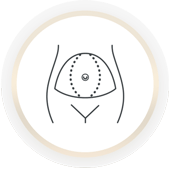
Step 2
The skin is lifted (except
for the belly button)
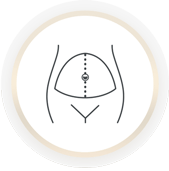
Step 3
The abdominal muscles
are tightened.

Step 4
The skin is pulled down
and excess removed
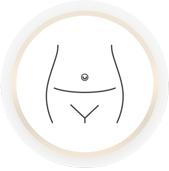
Step 5
The incision is sutured
1. The Lower Abdominal Incision is Made
If you are having a full abdominoplasty (tummy tuck), the incision (and the scar that subsequently forms) will be made across the lower abdomen at the level of your pubic hair and extend upwards and outwards on either side to your hip bones.
2. The Skin is Lifted
The skin is lifted from the abdominal muscles to the level of the rib cage. The belly button (umbilicus) is released from the lifted skin and remains attached to the abdominal muscles.
3. The Abdominal Muscles are Tightened
The abdominal muscles are tightened using sutures to bring them close together.
4. The Skin is Pulled Down and Excess Skin is Removed
The lifted skin is then pulled down firmly. The excess skin and fat are removed, and the umbilicus is stitched into its new position.
5. The Incision is Sutured
If you are having a lower abdominoplasty only, the incision might still need to be as long as the incision for a full abdominoplasty, but the skin is lifted off the abdominal muscles only to the level of the umbilicus and the umbilicus does not need to be separated from the lifted skin and stitched back into a new position. If you are having a mini-abdominoplasty, it might be possible to limit the incision and scar to the width of your pubic area, and the umbilicus will not need to be moved.
The outcomes shown are only relevant for this patient and do not necessarily reflect the results other patients may experience, as results may vary due to many factors, including the individual’s genetics and lifestyle.
Abdominoplasty Before and After – Real patients, real results

1 – Form & Face patient before and after abdominoplasty, side
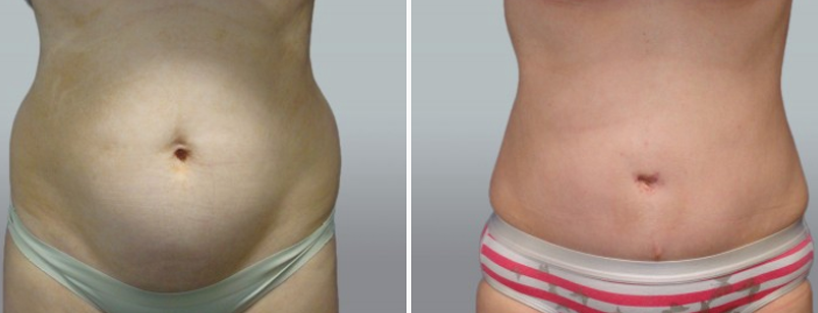
2 – Form & Face patient before and after abdominoplasty, front

3 – Form & Face patient before and after abdominoplasty, angle
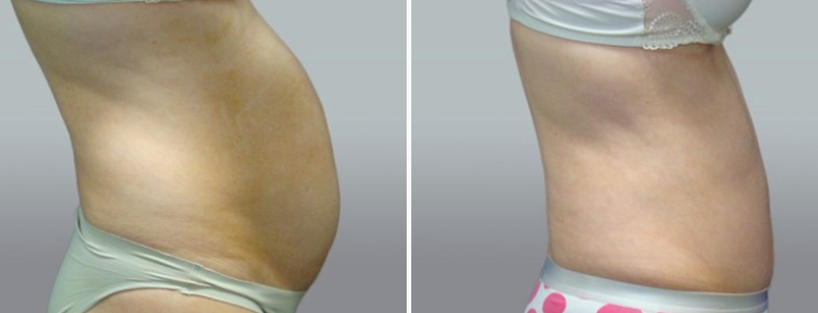
4 – Form & Face patient before and after abdominoplasty, left side
How much does abdominoplasty cost in Sydney?
Abdominoplasty is a personalised procedure, and every patient has different requirements, all of which will affect the final cost of the procedure. The type of abdominoplasty you choose and whether or not you decide to add on additional procedures will all make a difference to the final cost. Your final quote will also include the specific hospital and anaesthetist fees. The only way to get an accurate quotation is to schedule a consultation with Dr Norris, who can consider all of the necessary factors. The only time that Medicare or your private health insurance provider will cover some of the surgery costs is if it’s performed for reconstructive reasons. Dr Norris can explain more about rebates during your first consultation.
What happens after the surgery?
- Most patients will be instructed to stay in the hospital for a minimum of 3-5 days after abdominoplasty surgery.
- You might have your drains removed in the hospital. If not, these will be removed in Dr Norris’s clinic at your next appointment.
- You will require a friend, family member or partner to drive you home from the hospital, as your range of movement will be restricted. You may also feel drowsy after taking the necessary pain medication.
- Dr Norris will provide detailed aftercare instructions before you leave the hospital. You will also receive a prescription for pain medication.
- You cannot drive for up to 2 weeks, so patients are encouraged to make the necessary arrangements before surgery.
- Daily short showers are permitted, provided your waterproof dressings are dried adequately.
- For the first six weeks after surgery, patients are encouraged to sleep on their backs, propped up by pillows. Not only will this make your evenings more comfortable, but it will also help reduce swelling.
- You will experience the most discomfort in the first 3 or 4 days after abdominoplasty.
- You can return to work after about two weeks, but if your job is physically demanding, it’s best to take on lighter duties for the first three weeks.
- Swelling may take up to 6 weeks, but wearing compression garments will help.
- You can start light exercise about two weeks after the procedure and return to your normal exercise routine after six weeks, provided Dr Norris has cleared you to do so.
- You will have an appointment in the clinic after being discharged from the hospital to check and change the dressings and remove your drains.
Possible abdominoplasty complications
- Keloid Scarring – Sometimes, abdominoplasty scars can begin to look raised, lumpy and darker in colour. If this starts happening after surgery, speak to Dr Norris about treating the scars with steroid injections. Wearing your supplied silicone gel strips after surgery 24/7 will help prevent this.
- Haematoma – This refers to a collection of excess blood in the treated area. The blood is either absorbed naturally or will require surgical drainage. Symptoms include swelling, pain, bruising, hot skin to the touch, and itchy skin.
- Infection – Infection can occur if microorganisms enter the incision sites. Any type of infection should be treated as soon as possible using antibiotics.
- Seroma – It is possible for seroma fluid (leaking tissue fluid) to collect beneath the wound after the drains have been removed. If this happens, this fluid can be removed in the consulting rooms using an aspiration needle.
Abdominoplasty FAQs

Abdominoplasty is a surgical procedure that removes excess skin and fat from the abdomen and tightens the underlying abdominal muscles. It’s often considered by individuals whose abdominal area has been affected by weight changes, pregnancy, ageing, or past surgery. There are different types of abdominoplasty, depending on the extent of skin and muscle laxity. This procedure is not intended for weight loss, and patients are expected to be in good general health before surgery.
The cost of abdominoplasty in Sydney can vary based on the type of procedure you need, the inclusion of liposuction, and the specific fees charged by the hospital and anaesthetist. Some patients may also have partial cover from Medicare or their health fund if the surgery meets certain medical criteria. You’ll receive a detailed quote after your consultation, once your needs have been properly assessed. Pricing is personalised, so it’s not possible to provide a fixed cost without a consultation.
Medicare may provide a rebate for abdominoplasty if it meets specific criteria under the item number system, typically when the procedure is performed for reconstructive rather than cosmetic reasons. One common example includes patients who have experienced significant weight loss and are experiencing skin issues as a result. Even in cases where Medicare applies, only part of the surgical fees may be covered, and some costs are still out-of-pocket. Dr Norris will explain eligibility for any rebates during your consultation.
Abdominoplasty usually takes between three to four hours under general anaesthetic in a fully accredited hospital. The length of surgery can vary slightly depending on the technique used and whether liposuction is performed at the same time. You may need to stay in the hospital for a minimum of three nights. The duration of the procedure is planned in advance and discussed during your consultation.
Most patients are advised to sleep on their back, propped up with pillows, for the first six weeks after surgery. This positioning helps reduce tension on the incision and supports healing. Side sleeping can place strain on the abdominal area too soon, so it’s best to wait until Dr Norris confirms that your body is ready. Trying to sleep on your side too early may cause discomfort or delay recovery.
You will normally remain in the hospital for at least three nights following your surgery and may have drains in place for fluid removal. Once home, you’ll need to rest, limit your movement, and follow specific instructions on showering, dressing care, and medication. Driving is not permitted for about two weeks, and you’ll need support at home during the early stages of recovery. Regular follow-up visits will be scheduled to check healing and remove dressings or drains as needed.
Some patients may be eligible to apply for early release of their superannuation to help cover the costs of abdominoplasty if the surgery is deemed medically necessary. This process requires medical documentation and approval from the ATO, and not all applications are successful. If you are considering this option, it’s best to speak with your GP first. Dr Norris can also provide the required support documents after your consultation if appropriate.
Compression garments are usually worn for at least six weeks following abdominoplasty and liposuction. These garments support the abdominal area, help reduce swelling, and promote wound healing. You’ll be fitted with one during your hospital stay and given clear instructions on how long to continue wearing it. In some cases, you may need to continue wearing it during the day and night, especially in the early stages
After abdominoplasty, sleeping on your back with your upper body elevated is generally best. Using several pillows or a recliner can help maintain this posture, especially during the first few weeks. Sleeping flat or on your side too early can place tension on the incision and affect healing. Most patients adjust to the new position with time, and it becomes easier as the discomfort settles.
Most patients feel ready to return to light work and daily activities about two weeks after surgery. More physically demanding tasks should be avoided for at least three weeks, and strenuous activity or exercise is generally delayed for six weeks. Swelling can take several weeks to settle, and you’ll be monitored through follow-up appointments. Full recovery varies between individuals, but the initial stages pass within the first month.
You’ll be required to wear a post-surgical compression garment immediately after your surgery, which helps manage swelling and support the abdominal area. Outside of this, patients often choose loose, easy-to-remove clothing that doesn’t press against the abdomen. Button-up tops and soft waistbands can make dressing and movement easier during recovery. Garment wear is typically continuous for the first few weeks, depending on Dr Norris’s instructions.
There’s no specific ‘best’ age, but most patients are adults who have experienced changes to their abdominal area from pregnancy, weight loss, or ageing. It’s important that patients are physically healthy and have stable weight before considering surgery. For women, it’s generally recommended to wait until after completing their families. The decision is more about health status and physical concerns than age alone.
There’s no required size or weight for abdominoplasty, but patients should be close to their weight goals and not planning further significant weight loss. The procedure is intended to address skin, fat, and muscle issues that haven’t responded to exercise or dietary changes. Being overweight can increase surgical risks, so Dr Norris will assess your health status and body composition during your consultation. In some cases, weight management may be advised before surgery.
Abdominoplasty is not designed as a weight loss procedure, though some patients do notice a modest drop on the scale due to the removal of skin and fat. The actual amount removed varies between individuals depending on the type of procedure performed. It’s better to think of abdominoplasty as addressing changes in skin and muscle rather than aiming for a specific number of kilos. Patients are expected to maintain a healthy lifestyle after surgery to avoid further weight gain.

Here at Form & Face , we provide patients with a
Lifetime followup guarantee
ensuring long-term care & support